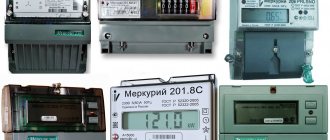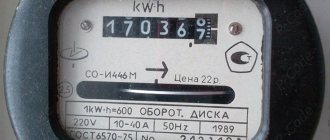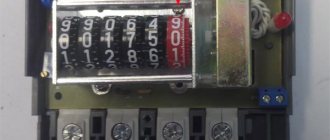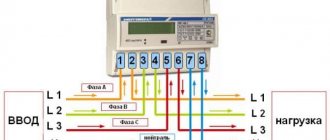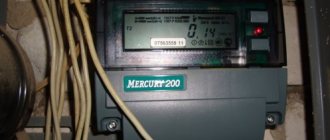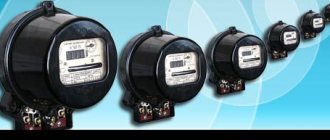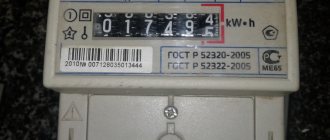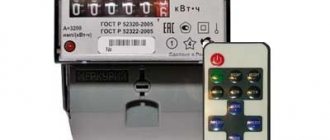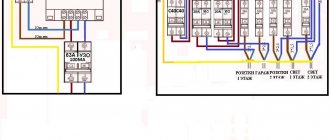The Mercury 230 meter is intended for metering all types of electrical energy in three-phase networks. It is two-tariff. Current measurement occurs via a transformer. Has the ability to transmit information through an interface via digital communication channels. It is used both in domestic buildings and in industrial enterprises and agricultural facilities. It is used both independently and in the scheme of systems for technological and commercial calculation tools.
Standard features of Mercury 230 (two-tariff)
- Measuring and storing data on consumed electricity, as well as its visualization on the display for the following time periods:
- From last reset;
- Within 24 hours;
- Within 30 days;
- For the current year;
- For the last year.
- The ability to meter electricity according to two tariff plans, for four types of days and 16 time zones.
- Ability to program monthly according to a new tariff schedule;
- Recording the following parameters:
- Instant calculations of any capacity;
- Actual parameters of potential difference, phase current, angles between phases;
- Electrical network frequency;
- Power factors separately by phase and in total.
- Protection control is carried out (maximum). There is a way to set the maximum allowable load power limit. If this limit is exceeded, the counter makes a note indicating the exact time value when the excess occurred.
- The load can be controlled via a digital output.
- The presence of event logs, the following values are recorded in it:
- The time when the meter was connected to/disconnected from the network;
- Disappearance and appearance of phases;
- Closing and opening the device;
- Correction of tariff schedule;
- Exceeding limits.
Additional counter features
Based on the modification, the device has additional functions:
- Forward and reverse metering of electricity;
- Energy metering for each phase;
- Saving an archive of received capacities at step-by-step intervals from 1 to 45 minutes. The archive storage time reaches 85 days;
- The maximum value of morning and evening power is recorded;
- Current quality is monitored;
- Losses and magnetic influence are taken into account - an entry is made in the log.
Technical data of the electricity meter Mercury 230
| Metering device accuracy class | 0,5 – 1 |
| Interface | RS-485, CAN, IrDA, PLC-I |
| Power supply from UPS | Eat |
| Number of pulse outputs | 2 |
| Self-diagnosis | Eat |
| Presence of a seal (electronic) | Yes |
| Parameter transfer protocol | Open |
| Dimensions | 260x170x75 |
| Weight, kg | 1,5 |
| Working temperature | — 40 + 55 C |
| Testimony protection | 2 access levels |
| Storage time of readings, years | 40 |
| Operating frequency | 50 Hz |
| Bit depth | 000000,0 |
How long will the SEB 2a 07.212 meter last?
This device is designed to count consumed electrical energy with a frequency of 50 Hz. With its help, you can carry out metering at three tariffs, separately at night and during the day, and also depending on the power level and quality of energy consumed.
The calibration interval of the SEB 2a 07.212 meter is 10 years. The average service life before major repairs is 24 years, while the warranty period is 3 years.
Flowmeters of this class have a special interface through which communication is carried out (RS-485). Thanks to this, such devices are successfully used as part of any automated information-measuring systems.
SEB 2a 07 electricity meters have many varieties, which differ in appearance, temperature range suitable for operation of the device, accuracy class, and form of displaying readings.
Meter Mercury 230, instructions for taking readings
The display shows visual parameters: date and time (current values), frequency of the measured network, total power factor, as well as separately for all phases, maximums - morning and evening, current and voltage value at a given time, consumption of active and reactive electricity, accuracy - up to hundredths of kW/h.
To take readings, you need to select the electricity metering tariff you are interested in by time of day:
Then multiply the value to a decimal point by the cost of the tariff, add the two resulting numbers and pay.
Licenses
When checking an electric meter, it is necessary to adequately understand two points - the cost of the verification procedure and the cost of installing a new meter. In many cases, it will be easier and cheaper to install a new, more modern meter. The specialists of 10 Kilovolt LLC have the appropriate license and extensive experience in installing electrical equipment - the replacement of the meter will be carried out as quickly as possible. Call us – our specialists will be happy to answer your questions.
| Price list for installation (replacement) and reprogramming of electricity meters | |||
| № | Job title | Unit change | Price, rub.) |
| 1 | Replacement (installation and dismantling) of a single-phase electric meter (single-tariff, multi-tariff) | PC. | 2000 |
| 2 | Replacement (installation and dismantling) of a three-phase electric meter (direct or indirect) | PC. | 3500 |
| 3 | Installation and replacement of current transformers in metering and protection circuits (up to 1000 V) | PC. | 3200 |
| 4 | Programming a tariff schedule or switching to winter/summer time | PC. | 1000 |
| 5 | Mercury 200.02 (single-phase, multi-tariff) | PC. | 1800 |
| 6 | Mercury 230 ART-01CN (direct connection) | PC. | 4700 |
Electronic or electromechanical electricity meters have an individual verification period, which is indicated in the passport of the metering device. After leaving the production line (a new electric meter), it is already verified and ready for use: on average, for mechanical meters the calibration interval is about 8 years, for electronic meters - from 10 to 16 years.
The period determined by the next verification date is considered the time interval during which the electric meter readings are considered correct. Verification allows you to determine the technical condition of the meter, the degree of wear of its parts and the correctness of metering of consumed electricity.
Peculiarities
Mercury 202, an electronic watt-hour meter for active AC energy, is designed to account for and display consumed electricity.
Single-phase, single-tariff.
Scope of application: production sites, apartment buildings, private households.
The overall dimensions of the device are comparable to the dimensions of old-style electric meters; its installation is carried out without alterations to instrument panels or measuring cabinets.
Advantages of the device:
- the design of the device is reliable and durable;
- ease of connection;
- readings are easy to read in devices with both a digital mechanical counter and a liquid crystal indicator;
- Some modifications have a telemetric output intended for remote data transmission and are used in automated systems for monitoring and accounting for electricity consumption;
- free repair or replacement of the device during the warranty period.
Operation of the Mercury 202 meter did not reveal any design flaws; the only remark is the unstable operation of liquid crystal indicators in some modifications at temperatures below -30 degrees Celsius. These deviations are provided for in the technical specifications for the meter.
Judging by the reviews, this is an accurate, reliable and durable device. Without a set of “advanced” options (for example, it cannot work with several tariffs, like a day-night meter). But at a reasonable price.
Electric meter Mercury 230 AM-1
Verification of the electric meter is the responsibility of its owner, after agreement with the electricity supplier. If the frequency (terms) for checking electric meters is met, and the consumer suspects that the meter is counting incorrectly, additional tests may be prescribed. To prevent this from happening, it is recommended to use proven models of electricity meters, for example Mercury 230 and subsequent series - our experience can guarantee this.
Additional verification of the metering device is carried out at the standardization center, and a specialist from the energy sales company must localize the latest meter readings: take current readings, draw up a report on the removal of the device and transfer payment for electricity based on average indicators.
Metering devices that have successfully passed verification are sealed: the seal of the company that carried out the verification is installed on the fastening of the casings, and the seal of the electricity supplier is installed on the cover of the terminal block. When checking the device, its compliance with the declared accuracy is revealed; for multifunctional electricity metering devices, the accuracy and its additional capabilities are checked.
Complete set, installation features, connection diagram
The electric meter is supplied in a package with a technical passport, which reflects the main parameters of the device and operating conditions. In addition, organizations performing verification may additionally be supplied with a verification method, a technological device for programming, a device for reading information, and for organizations specializing in repairs - a “Medium Repair Guide”.
Installing an electric meter is not particularly difficult. The device is mounted on a standard DIN rail in compliance with electrical safety regulations.
The meter is connected to the electrical network directly, without any additional devices; the power and load wires of the network are connected to the meter terminals according to the connection diagram attached to the technical data sheet.
When installing the meter, a corresponding mark must be made in the technical data sheet.
If the meter is found unsuitable for use
If the conclusion of the metrological service indicates that it is impossible to use the electric meter, it is considered unfit for use and must be replaced. Inconsistency of the device with the accuracy class, violation of tightness, etc. – means that the meter is faulty. When replacing it, an electricity meter replacement certificate , which is presented to representatives of the energy sales company during the sealing procedure. Sealing of the electric meter by the electricity supplier company should be free of charge.
What to do if the MPI has expired
How to understand that the meter needs to be replaced.
If your electricity meter has expired, you need to contact your utility service provider. A written notification is drawn up about the need to diagnose IPU. During device research, fees for resource consumption will be charged based on average indicators.
If the IPU is not verified and installation is not carried out within 3 months, then receipts will be issued in accordance with the standards relevant in the consumer’s region of residence. Each subject of the Russian Federation has separate regulations for such cases. Experts recommend purchasing a new sealed electric meter, since in most situations, after diagnostics, the non-working state of the old IPU becomes clear.
Who has the right to verify the electric meter?
A company that has permission to do so has the right to check the technical condition of the electric meter, replace it, install it and verify it. In addition to the permit, the company must have specialists capable of providing such services in a high-quality and professional manner - and our company has these qualities to the fullest extent. The tasks of our clients - installation and verification of electricity meters in Moscow and the Moscow region - have been successfully completed for many years.
According to Federal Laws of the Russian Federation No. 102 and No. 261, only verified metering devices can be used. Verification includes many important nuances that should be dealt with if you do not want to pay a fine in case of delay in the verification interval. What is the verification interval, verification, when and where to hand over your meter and is it possible not to hand over? You will receive answers to these questions in this article.
Verification
carried out according to document AVLG.411152.021 RE1 “GSI. Three-phase static electricity meters “Mercury 230”, “Mercury 230”. Verification methodology”, approved by LLC “ITsRM” on July 16, 2020.
Basic means of verification:
— universal verification unit UPPU-ME 3.1K (registration number in the Federal Information Fund No. 39138-08);
— electronic counting frequency meter Ch3-63 (registration number in the Federal Information Fund 9084-83).
It is allowed to use similar verification tools that ensure the determination of the metrological characteristics of the meters being verified with the required accuracy.
The verification mark is applied to the verification certificate and the seal on the meter housing.
What is the verification interval and how long can it be?
The inter-verification interval is the time interval after which you will need to verify the meter, since without timely verification the device is considered inoperative, and its readings are not accepted for calculation.
For each type of electric meter, its own specific time interval is established, during which its readings are recognized as correct and valid. This interval depends on the model and type of meter, but on average ranges from 4 to 16 years. You can familiarize yourself with the verification interval in your specific case in the electric meter passport.
Mercury 201 counter. Description of the Mercury 201 counter.
The Mercury 201 counter is one of the most common meters in our country. In this article I will talk about the single-phase single-tariff meter Mercury 201.5. Mercury meters from Incotex LLC, along with Energomera meters, occupy leading positions in the Russian market, primarily due to their low price, which averages 550-600 rubles.
If you have not yet decided which electric meter to buy for your home, the article “How to choose the right electric meter for your home” will help you choose exactly the meter you wanted.
You decide to replace the old meter, or you are connecting a new house, apartment, country house or garage, and you need to buy a new meter. Let's assume you decide to install a Mercury 201 series counter.
Before you buy a Mercury 201 meter, we check whether it meets the basic requirements for commercial metering of the retail electricity market:
1. The accuracy class of the Mercury 201 meter is 1, according to the requirements no more than 2.
2. Date of release of the Mercury 201 meter, which is also the date of verification of the electric meter: 03/23/2014. — less than 2 years, because Mercury 201 meter is single-phase. For three-phase meters it will be 1 year.
3. The Mercury 201 meter is included in the State Register of Measuring Instruments under number No. 24411-04
Therefore, the Mercury 201 counter fully satisfies the requirements.
The standard package of the Mercury 201 meter includes:
- Actually, the Mercury 201 counter itself.
- Passport and instructions for the Mercury 201 meter.
- Adapter plate with connecting dimensions for replacing an induction (disc) electric meter with a Mercury 201 meter. Since 2015, not included in the package.
This series of Mercury 201 meters has several different modifications:
As can be seen from the passport for the Mercury 201 meter, they are produced:
- with a maximum current of 60 or 80 A;
- with an electromechanical reporting device (conventional mechanical “drum”) counter Mercury 201.5, 201.6, 201.7;
- with liquid crystal display counter Mercury 201.2, 201.4, 201.8;
- can be equipped with a modem for remote readings;
- different number of transmitted pulses (telemetry).
A hologram is pasted onto the Mercury 201 counter, protecting it from counterfeiting.
The warranty seal, which indicates the release date of the Mercury 201 meter, in our case the month of March (3rd) and the 14th year are painted over. The warranty on the Mercury 201 meter from the manufacturer is valid for 3 years.
The stamp of the state verifier, which means that the Mercury 201 meter corresponds to the declared accuracy class of 1. The stamp can be used to determine the date of verification; our Mercury 201 meter was verified in the first quarter of 2014.
The Mercury 201 counter can be installed either on a DIN rail or
and simply screw it onto the back wall of the electrical panel using an adapter plate, which in turn is inserted into the clamps under the DIN rail. This plate “holds” the Mercury 201 counter quite tightly.
How to install a Mercury 201 meter in an electrical panel can be found in the article “Replacing an electric meter.”
As a rule, on the inside of the terminal covers of the electric meter, a diagram of the connection of electric meters is shown, and our Mercury 201 meter is no exception.
Perhaps the connection diagram for the Mercury 201 meter on the terminal cover is not entirely clear, so we will complete it to make it easier for you to understand.
A small terminal block with two contacts is the telemetric (pulse) output of the Mercury 201 meter. It is used for remote transmission of data (pulses) about electricity consumption.
So that after connecting the phase and neutral wires to the Mercury 201 meter they do not interfere, the perforation on the terminal cover is broken out and bitten out, and the terminal cover is screwed into place, tightly fitting to the body of the Mercury 201 meter.
After checking the connection diagram of the single-phase Mercury 201 meter and installing the terminal cover, the Mercury 201 meter is sealed by a representative of the network organization through a special hole.
The red light indicator of the Mercury 201 meter lights up when the meter is connected to the power supply.
The readings of the Mercury 201 meter are quite simple to determine; on the mechanical reading device (OD) there are six drums with numbers, the red drum of the Mercury 201 meter is tenths of kW*hours, and the five black drums of the Mercury 201 meter are integer values of kW*hours.
Thus, in the photo above, the Mercury 201 meter accumulated 1.5 kWh. Integer values are transmitted to the network organization and energy sales, so if anyone is confused, you can paint over the red drum of the Mercury 201 meter.
Despite the popularity of Mercury counters, I have my own opinion about them, and not in a very good way.
I’ll explain why, Incotex has a series of single-phase multi-tariff single-phase meters Mercury 200, which literally disfigure electrical panels; you have to cut out a window for the Mercury 200 meter, since they don’t fit there. And in the end it all looks very ugly.
What is also important, when completing the electrical panel, the Mercury 201 meter has larger dimensions than its counterparts in this price category with similar parameters. So, for comparison, the width of electric meters:
| Electricity meter | Manufacturer | Width, mm |
| Mercury 201 | Incotex | 105 |
| CE101-R5 | Energy meter | 89 |
| Neva 103 | Typepit | 78 |
Accordingly, Mercury 201 meters take up more space in electrical panels, which sometimes introduces additional inconvenience, and sometimes additional financial costs, because you have to buy an electrical panel for a larger number of modules.
The Mercury 201 meter is inconvenient to seal; several electric meters had to be manually “adjusted” to holes specially designed for this purpose so that a wire or fishing line could fit through them for the seal.
How to properly connect a single-phase meter Mercury 201 to the electrical network can be read in the article “Connection diagram for a single-phase meter”.
Thank you for your attention.
elektroschyt.ru
Period for checking the electric meter in the apartment
According to one of the principles of classifying meters, there are 2 types: mechanical and electronic. The first loses its relevance over time and is now mostly used in buildings of the old type. Despite its durability, reliability and low price, a mechanical counter has a number of disadvantages, the most significant of which is its low accuracy class. Therefore, today electronic meters are in great demand. Their advantage is as follows:
- the possibility of multi-tariff metering of used electrical energy;
- longer verification interval;
- compact dimensions;
- minimal error in electricity measurements due to a higher accuracy class compared to induction (mechanical) meters;
- the ability to determine the parameters of the electrical network (power consumption, voltage, phase-by-phase load current).
Depending on the phase current, electric meters are in turn divided into single-phase, two-phase and three-phase.
Verification period for each type:
For single-phase - 2 years
Connected to a single-phase network. Also, for example, you can connect 3 single-phase meters to a three-phase network. If you want to delve deeper into the theory, you can read more about the types of networks here.
For two-phase - 1 year
For three-phase - 6 months
If single-phase electricity meters are connected only to single-phase networks, now there are three-phase devices that allow you to connect not only to a three-phase, but also to a single-phase network.
Important! If your meter belongs to accuracy class 2.5 (this can be found out by looking at the passport), it must be replaced at the end of the verification interval, since in accordance with GOST 6570-96 “Inductive active and reactive energy meters” class metering devices Accuracies of 2.5 are limited to the first verification interval and their verification is not carried out again; they are subject to mandatory replacement.
Do you want to change the meter yourself? Remember that only an employee of a medical center or an accredited organization can remove the seal, after which you can begin replacing the electric meter. An example of how to replace a device yourself can be found here.
Verification period for electricity meters "Mercury"
Counters are considered the most common today. They replaced outdated mechanical devices with a rotating wheel. Since this model is most popular among the population, let’s consider the characteristics of several of its types in more detail:
Please note that the calibration interval for all five models is 16 years. In other words, 16 years after the initial verification of the meter, which is indicated in its passport, you should take steps to verify it. Read what exactly you need to do at the end of this article.
Verification period for two-tariff electricity meters
In 2022, electricity prices rose, and two-tariff meters became relevant. Despite the fact that such devices are more expensive than conventional ones, they justify their price in the future, allowing you to save on energy bills. The verification period for such meters, as mentioned earlier, depends on the model, but, as a rule, is 16 years.
Types of counter
The manufacturer produces eight modifications of the Mercury 202 meter. The models differ only in the type of information display: a digital electromechanical device or a liquid crystal display, and functional features.
202.1
The device is designed for operation in electrical networks with a rated and maximum current of 5 and 60 A.
Equipped with an electromechanical information display device.
202.2
Permissible current load 5 and 60 A.
In this model, information is displayed on a liquid crystal display.
202.22
The modified model 202.2, the built-in modem provides remote data transmission via additional communication channels.
202.3
The model is designed for operation in electrical networks with current loads of 10 and 80 A, respectively. Information is displayed on an electromechanical digital device.
202.4
The model is designed for electrical circuits with a current load of 10 and 80 A. Information is displayed on a liquid crystal display.
202.42
Modified model 202.4 for remote data transmission, built-in modem.
202.5
Its parameters are similar to model 202.1, it differs only in the gear ratio, this parameter does not affect the accuracy of measurements.
202.6
Compared to model 202.5, it is designed for higher load currents of 10 and 80 A.
Features of meters with large calibration intervals
The electronic meter, which has some operating features, has the largest calibration interval. Its design includes non-volatile clocks and counting elements that save data in the event of a power failure. Thanks to this, when turned on after an emergency blackout, all information about the level of electricity used will not be reset to zero. Also, these devices have their own software that automatically adjusts the time, which is important when using several tariffs. Such devices also have protection against unauthorized access, which records such attempts in the event log.
Important! Remember that your electricity meter is not the CSM’s problem, but yours and only your concern.
Responsibility for its performance falls on your shoulders. Therefore, the question often arises: what to do if the verification interval has expired?
Counter Mercury 201.5
8 (495/499) 290-39-83,
My basket:
Categories
- Cable and wire
- Junction boxes, Terminal blocks, Clamps
- Wire boxes
- Corrugated / smooth hoses (PVC / HDPE)
- Cable trays
- Circuit breakers
- Differential automatic machines (Differential automatic machines)
- RCD
- Counters
- Boxes, Shields
- Switches, Disconnectors
- Lamps LPO (IP 44), LSP (IP 65), Armstrong
- Spotlights, street lamps RKU, ZhKU, RSP
- Lamps and starters
- Step-down transformers, chokes for lamps, lamp protection units
- Plugs, Connectors, Extensions
- Sockets and switches
- Dimmers
- Industrial connectors
- Fasteners, cable tie, clip
- Tips, Sleeves
- Relays, Starters, Contactors
- Buttons, remote controls
- Fuse links
- Telephony, Television, Computer networks
- Heat shrinkable tube
- Materials
- batteries, batteries
- Heaters, heated floors
- MISCELLANEOUS
- Light indicators
- FURNITURE
- BED SHEETS
- Home page
- »
- Counters
Description of the Mercury 201.5 meter
Mercury 201.5 meters are designed for commercial metering of active electricity in single-phase alternating current circuits and operate both autonomously and as part of an AIMS KUE.
Design features of the Mercury 201.5 meter
- technological reserve by accuracy class;
- the use of a shunt to measure current allows measurement in the presence of a constant component;
- pulse telemetry output for verification and inclusion in AIMS with data collection via telemetry;
- small dimensions of the Mercury 201.5 meter;
- screwless meter housing;
- protection against electricity theft by polarity reversal;
- mounting the Mercury 201.5 meter on a DIN rail;
- The Mercury 201.5 meter is equipped, upon customer request, with an adapter plate with the connecting dimensions of induction meters.
Technical characteristics of the Mercury 201.5 meter
| Name | Counter Mercury 201.5 |
| Accuracy class | 2.0 (1.0) |
| Rated voltage, V | 230 |
| Base (max.) current, A | 5(60) |
| Network frequency, Hz | 50 |
| Starting current (sensitivity), mA | at Ibase=5A - 20at Ibase=10A - 40 |
| The active (apparent) power consumed by the meter voltage circuit does not exceed, W (VA) | 0,5 |
| Display device | OU |
| Gear ratio imp./kWh | 3200 |
| Power Line Interface (PLC) | — |
| Operating temperature range, °C | -40… +55 |
| Overall dimensions of the Mercury 201.5 meter, mm | 105 x 105 x 65 |
| Weight of Mercury meter 201.5, kg | no more than 0.35 |
| Calibration interval of the Mercury meter 201.5, year | 16 |
| Manufacturer's warranty on the Mercury meter 201.5, years | 6 |
| Service life of the Mercury 201.5 meter, year | 30 |
Product reviews
Leave feedback
- Reviews
- Price list
- Articles
- Our services
- Payment Methods
- Load and cable weight
cable-provod.ru
